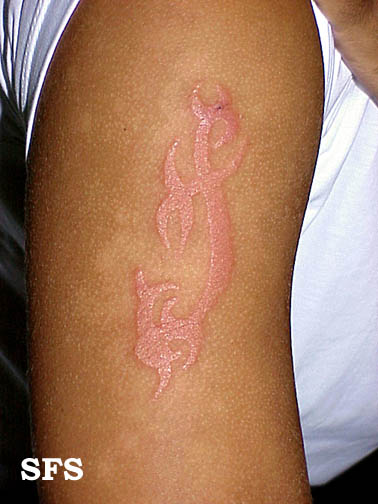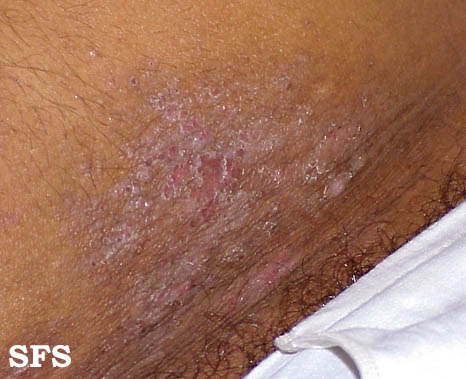Allergic Contact Dermatitis Symptoms, Pictures, Treatment
Contact dermatitis is inflammation of the skin resulting from exposure to certain substances. The inflammatory process causes the blood vessels in the skin to dilate thereby leading to greater blood flow. Fluid leaks out into the tissue. Certain inflammatory chemicals also irritate the tissue of the skin. Therefore the skin becomes red, swollen, hot to touch and itchy or even painful. If prolonged, the skin will eventually become dry and even scaly as skin health is compromised.
Some of these substances in contact dermatitis can irritate any person’s skin. This form of contact dermatitis is known as irritant contact dermatitis. In other cases the substance only causes skin inflammation in hypersensitive individuals as a result of an allergic reaction. This type of contact dermatitis is referred to as allergic contact dermatitis. The triggers of irritant and allergic contact dermatitis differ since the process by which the skin inflammation arises is different.
What is allergic contact dermatitis?
Allergic contact dermatitis is a type of inflammatory skin disease caused by the sensitivity of the immune system to certain substances known as allergens. When the skin is exposed to these substances, immune activity is triggered thereby leading to skin inflammation. It does not occur in every person and hypersensitive individuals are more likely to develop allergic contact dermatitis. It should not be confused with another type of allergic dermatitis frequently seen in children known as atopic dermatitis or commonly referred to as eczema. However, people with atopic dermatitis are at greater risk of allergic contact dermatitis. Nevertheless, both types of allergic dermatitis are considered as separate entities.
How does allergic contact dermatitis develop?
Allergic contact dermatitis is a delayed type of sensitivity. First the body has to develop a sensitivity to the substance. This happens at the time of first exposure – within days after exposure. This process is known as sensitization and typically takes about 10 to 14 days following exposure to the substance. Sometimes it can take years of constant exposure to the substance for sensitivity to develop. Once sensitization has occurred, a person will react to the substance (allergen) upon subsequent exposure, often within minutes and hours but sometimes within days. This is a type IV cell-mediated hypersensitivity allergic reaction.
First Exposure
Upon first exposure, the following processes occur for sensitization.
- Substances (allergens) are trapped by Langerhans cells, a type of immune cell in the epidermis of the skin.
- These cells the migrate to the lymph nodes in the area of the site of exposure.
- Here the T cells, another type of immune cell, are exposed to the substance.
- Sensitized T cells then migrate to the epidermis.
Subsequent Exposure
Upon re-exposure to the substance the following occurs.
- Sensitized T cells are activated.
- Cytokines are released.
- Inflammatory cells are recruited to the site.
- Inflammation ensues.
Causes of Allergic Contact Dermatitis
There are various different substances that can act as allergens. These substances are not the cause as such but rather the triggers of the inflammatory reaction in allergic contact dermatitis. It includes :
- Metals such nickel, cobalt and mercury. Exposure to these substances may occur in occupational settings or as a result of wearing jewelry containing these metals over long periods of time. Nickel is the leading cause of allergic contact dermatitis.
- Hair dye allergy is mainly related to a substance known as para-phenylenediamine (PPD). It is mainly the skin on the scalp, neck and face that is affected due to direct contact with the allergen. A similar allergy may occur on other parts of the body with the use of henna.
- Plants and plant material such as poison ivy, ragweed pollen, primrose, oak and sumac are naturally occurring allergens.
- Medication such as antibiotics, antihistamines, anesthetics like benzocaine, neomycin, corticosteroids and some NSAIDs ointments. Some of these topical applications only become allergenis upon exposure to sunlight.
- Cosmetics such as deodorants, nail polish, foundation and hair removal agents like depilatories and certain waxes. It is important to remember that with allergic contact dermatitis it is a matter of individual sensitivity.
- Fragrances in colognes, deodorants, perfumes and even household products such as air fresheners and detergents.
- Latex in condoms, gloves and catheters.
- Industrial chemicals used for textile and shoe manufacturing and for various other purposes.
There are scores of different substances that may act as allergens. Those mentioned above are some of the more common agents.
Signs and Symptoms
The clinical presentation of contact dermatitis, whether irritant or allergic, is largely the same. It includes :
- Rash which varies – redness, tiny blisters, few large blisters, dryness and peeling or ulcers.
- Itching more intense that with irritant contact dermatitis where pain is more likely.
- Pain especially when the skin has peeled raw or become infected.
- Symptoms mainly at the site of contact which can spread locally or even throughout the entire body.
As with irritant contact dermatitis, the hands are most often affected in allergic contact dermatitis as it is more likely to make contact with different substances. However, it large depends on the allergen. A wrist watch or neck chain may cause symptoms at these sites. The scalp, neck and face are more often affected in allergic contact dermatitis.
Other symptoms like a fever, pus, intense pain and heat at the site are typically associated with a secondary bacterial infection. It tends to arise with repeated scratching of the site.
Pictures
For more pictures refer to irritant contact dermatitis pictures as the presentation is very similar.
Treatment of Allergic Contact Dermatitis
The treatment of allergic contact dermatitis is not significantly different from irritant contact dermatitis. The key is identifying the allergen and avoiding exposure to it as far as possible. Treatment of allergic contact dermatitis includes :
- Corticosteroids are the main treatment option for allergic contact dermatitis. It should, however, not be used in the long term as far as possible.
- Oral antihistamines mainly to reduce itching.
- Emollients to ease skin dryness in the long term.
- Cold water compress over the affected site.
- Topical immunomodulators if corticosteroids are not proving the desired results or the dermatitis is persistent.
- PUVA treatment (psoralen and ultraviolet light A) is sometimes used in chronic cases.
- Immunosuppressants are rarely used but may be considered in severe cases.







